President's Message
I hope you will join us for our 41st Annual meeting to be held at our official headquarters at Dabbs House Museum. Dabbs House Museum is a multi-era historic site and in addition to housing the Henrico County Historical Society, it is also the location of the Henrico County Tourist Information Center.
We are looking forward to introducing you to our new headquarters. Researchers will be on hand to answer questions you may have on searching your family ancestry and other historic information. The USS Henrico collection will be available for viewing, and we will tour General Robert E. Lee's headquarters. Also, a tour of East End Cemetery will be offered by John Shuck.
Also a video clip with be presented in recognition of HCHS's 40th anniversay by Henrico County Public Relations and Media Services. Former HCHS President, Beverley Davis and I were interviewed. Bev did a wonderful presentation, and we thank her. I have to reveal that while I have other strengths, I am not a good interview candidate...a movie star I would not make.
First of all, my phone rang while the camera (including sound recording) was underway, at which time I apologized profusely and promptly put it on vibrate. Then all I could hear was buzz, buzz, buzz while the camera/sound recorder was again underway. Sometimes I call them my "Lucy moments" if you remember the "I Love Lucy" programs and the situations in which she found herself.
In spite of it all, Geoffrey Weidele, Producer/Director for Public Relations and Media Services, did a brilliant job of editing. He put a tremendous effort and input of time to present this recognition, and I think you will be pleased. Kudos to Geoff and all those folks at Media Services!
In September we will be meeting at the Virginia Randolph Museum, where Mt. Olive Baptist Church of Glen Allen will present the history of their church, which will soon be celebrating their 150th anniversary. A number of Mt. Olive members attended Virginia Randolph School and will be able to present "first person" knowledge of the school. A tour of the museum will be given as well as a presentation on African American Trailblazers. At the December 4th meeting, we will be recognizing the 50th Anniversary of Pearl Harbor. Those plans are still underway. We look forward to honoring the "Greatest Generation" and hope you will also join us for that tribute.
Best wishes,
Sarah Pace
President
>Back to Top<
June Quarterly Meeting
Join us Sunday, June 5 at 2:30 p.m. The Board Meeting is at 1:30 p.m.
Dabbs House Museum, located at 3812 Nine Mile Road in Henrico, VA 23223.
We will have an open house of the Henrico County Historical Society's new office, and our researchers will be on hand to answer questions. Then we will tour the historic section where Robert E. Lee had his headquarters during the Seven Days Battle. John Shuck will also offer a tour of the nearby East End Cemetery where he has spearheaded a long-running reclamation project.
>Back to Top<
HPAC 2016 Awards of Merit
On Wednesday, April 27, Henrico County's Historic Preservation Advisory Committee held its Awards of Merit ceremony at Deep Run Recreation Center. We congratulate the recipients and thank them for their efforts in preserving the history of our county.
The award recipients included:
- Antioch Baptist Church
- Cathy Boehling
- Mary Boehling
- Donna Meade Dean-Stevens
- Brian and Erin Hollaway Palmer
- The Henrico Concert Band
- Elizabeth Kostelny (Preservation Virginia)
- Fred Fisher (Partnership for Smarter Growth)
- Leighton Powell (Scenic Virginia)
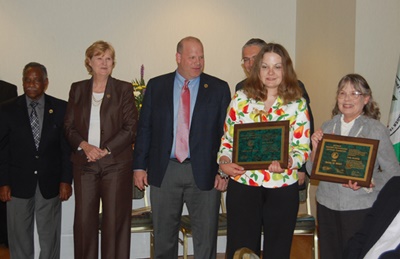
Pictured: Supervisors Frank J. Thornton (Fairfield), Patricia S. O'Bannon (Tuckahoe) and Thomas M. Branin (Three Chopt) and County Manager John A. Vitoulkas pose with HCHS members Mary and Cathy Boehling, two of the Award of Merit recipients.
>Back to Top<
March HCHS Meeting
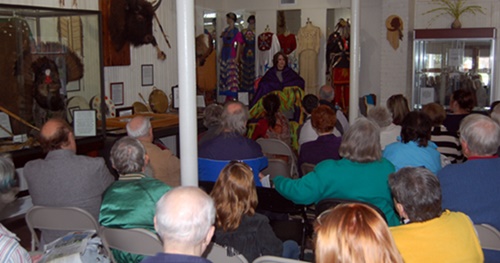
Annette Price, co-founder of the Wolf Creek Cherokee Museum on Osborne Turnpike in the county's east end, addresses the Henrico County Historical Society on aspects of the tribe's culture.
>Back to Top<
County Dedicates the Maybelle Carter Family Residence Historic Marker
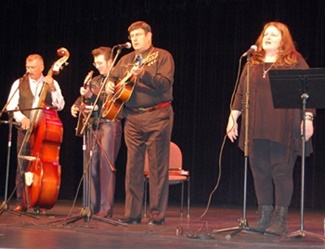
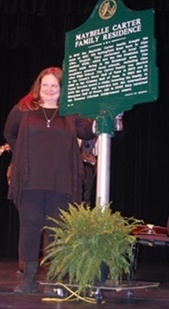
On April 10, county music singer Lorrie Carter Bennett, daughter of Anita Carter and granddaughter of Mother Maybelle Carter, performed with Ronnie Williams and the Carter Family Sound at the dedication ceremony for the historical marker commemorating the Carter's Henrico County home in the late 1940s and early 1950s.
The marker, funded by the Association for the Preservation of Henrico Antiquities, will be placed at the site of the home at 4101 Old Springfield Road in Glen Allen.
>Back to Top<
1864-65 Diary Shows a Sensitive Sould with a Sense of Lyricism: Emma Mordecai at Rosewood
Diaries are wonderful records of times, events, customs, observations and musings. Thanks to Samuel Pepys, Mary Chesnut, Anne Frank and others we can visit the past in a most personal manner. Their records are monumental works with broad influence. But for every Pepys, Chesnut or Frank, there are untold numbers of journal keepers whose works never, or rarely, see the light of day. And these "ordinary" volumes also have the power to educate and inspire. They illustrate for us the human need to preserve meaningful experiences, and the artistry present in each of us.
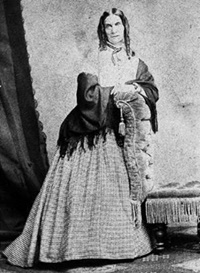
Emma Mordecai, in a Richmond studio protrait. (Mordecai House, Raleigh, NC. From General Negative Collection, State Archives of North Carolina)
Emma Mordecai kept a diary during parts of 1864 and 1865 at Rosewood in Henrico County, and her journal shows her to be a poetic and thoughtful observer. The forty-one year old spinster had left her Church Hill home and come to help her sister-in-law, Rosina Ursula Young Mordecai, at the farm, which occupied the land we know today at Bryan Park. Her accounts of military actions around her, of the foods they had and had to put up with, of prices and of her observance of Jewish holidays and customs fill the diary and are interesting in their own right. But the writing itself reveals a sensitive soul with a flair for the language - a quality most likely at the heart of almost every diarist.
A nice example of her poetic flair and thoughtful cast of mind can be found in her 6 May 1864 entry. In considering the progress of the Civil War, she writes that she "Felt grateful for this [victory at Chancellorsville],but what sadly tempered joy, do we hear of our successes -- We do not know who may have fallen; we know that may have, dear to others if unknown to us. It is said that the great battle is being fought today; also that several of our Genls. fell on yesterday." And then she takes note of her surroundings, writing, "As I sit by my open window this lovely May morning, with the quiet green slopes of the little hills stretching down to the beautiful water; nothng heard but the tinkling of the cow bells as they snatch their last browse for the evening, & the twittering of the birds, how unlike is the scene before me, to the frightful onslaught, the carnage, & the thundering of the artillery that are at this moment going on, less than fifty miles from us. It is utterly impossible to realize the fact, & our quiet composure under such circumstands is an unsolvable problem of human nature." Trepidation regarding the present war conditions leads her to consider its contrast with her own surroundings then on to a conclusion about the human condition - not bad for an "ordinary" diarist.
Her lyrical ability to describe the natural environment is on display again on 28 May 1864 when she records the following: "A most beautiful morning, took a sweet little ramble in the woods about Laurel Branch, after breakfast. Got honeysuckle, laurel, lupin & other flowers -- Grape vines not quite in bloom yet. How tranquil it was in the wooded pasture, where the cows look as if they would tire themselves with grazing, so uncommonly luxurient [sic] is the growth of grass & clover in the woods around." So moved by the tranquility of the scene, she imagines that some tranquility affecting even the cattle.
Lyricism and recognition of contrast between the internal and external worlds come through again in her 11 May 1865 notation. She writes: "A day of rare beauty, following a stormy night -- The air so clear, & cool, the sky so blue, & the slopes of the leafy woods so green. The birds are numerous and the air is filled with their warbling. Thus it is in the outer world. Within, there is no beauty, no enjoyment, no harmony."
On 14 November 1864, Emma traveled to Richmond on a day that was "Clear & extremely cold;" and she had another flash of lyricism when she noted that there was "Ice & sparkling frost everywhere." The poetry continued, along with her affinity for contrasts, when she went on to say that she "Saw many old acquaintances & made a very pleasant new one. Sold some things & bought some. Everybody, now sells whatever they do not need. Had altogether a pleasant visit, but passed my time in such busy idleness that I came home quite demoralized." The delightful oxymoron "busy idleness" illustrates the tension brought on by her new purchases and necessitated sales - the impulse of a poet.
And the poet must be a sensitive soul, one yearning to make a connection; and Emma Mordecai, it seems, sought those connections. One of her regular activities involved visiting wounded at the Richmond area hospitals, and all her interactiosn with the patients show both the conditions of wartime medical care and her sensitivity. However, her dealings with two particular individuals provide real insight into her sensitivity and humantity.
On 25 May 1864, she was driven to a hospital where she "staid all day." She recorded that "My heart bled for the noble, uncomplaining, all-enduring heroes. I did all I could for them; gave them ice-water, and bathed their wounds -- constant applications of cold water, almost the only treatment used in gun-shot wounds. One splendid-looking man with fine features & most excellent countenance, was suffering agony in what was left to him of his bold right arm. It had been shattered by a shell, & in this condition he had walked a mile without assistance. This was on Monday evening -- on Tuesday the arm was taken off below the shoulder, & on Wednesday (this) night he reached the Hospital after riding up from Charles City Co. partly on horseback & partly in an ambulance."
The following day she "Went to the Hospital after breakfast ... Found my interesting Cavalry man still there suffering intensely. I bathed his wound. He had a nervous chill. Succeeded in getting him some liquor, which he drank & said he knew it would do him good. I rubbed his feet, (he had on a clean pair of nice socks) which were very cold. He complained of a most intolerable itching in the hand he lost, and tried, involuntarily, to rub the spot where his hand would have been, if he still had it. (Many of the men complain of severe pain or discomfort in the limbs they have lost.) He was transferred to another hospital in the course of the day, & I have lost sight of him as I am constantly doing of those I am interested in."
She did lose sight of him, apparently never seeing again; yet despite her awareness of the transience of those connections and the discomfort their fleetingness caused, she continued to clutivate them.
And then there was Horton. On 29 May 1864, she was carried to the hospital where she "carried my favorite patient, Mr. Horton, of Georgia, a breast of chicken, & a slice of bread & butter. Found him less well than when I left him Friday. He eat part of it, & seemed to relish it, but has little appetite. He has much to content with. Has lost his left foot, and was severely wounded in the right leg. Poor fellow! So brave & so handsome -- with his white forehead, soft chesnut hair, clear steel blue eyes -- straight nose & expressive mouth."
She records arranging with a Doctor Hughes to visit Horton, and then on 9 June 1864, she returned. She writes: "Spent the day at Westbrook after riding in to see Mr. Horton. Rose had some excellent chicken soup made for him, which took to him -- but, poor fellow! he was too low to enjoy it, or to take much notice of any thing. My heart is sad, & my mind troubled about that interesting young man. He has been neglected. With proper care he would have recovered. God has willed it thus, but we cannot reconcile ourselves to such things as we can to death in battle, or to death after all human efforts have been made. I shall never forget the look of patient, despairing, uncomplaining submission to the inevitable that was the constant expression of his countenance. He had no one to attend to him except at stated periods. No one to keep off the swarming flies or to answer the many urgent requirements of such a sufferer. Comfortless & perhaps without any one's knowing it, he will die. The sisters do not allow any outsiders to remain with a patient but 15 minutes, so I had to leave him after this short time. I shall probably not find him there when I go again. I have prayed for him -- May God pardon and take him to Himself." Again, as with the conditions in her natural sourroundings, Emma cannot resist extrapolating her experience and emoteional response to humans in general.
Unfortunately, her fears for Horton's fate was not unfounded, for on 15 June 1864, she "went to St Frances de Salles, near by, to hear of Horton, & get some things I had left there. Poor Horton, I learned, had lived until the Monday morning after I last saw him - I had not thought he would live so long."
That sensitive woman was not without her venom, but her venomous observations were not without artistry. Her 28 August 1865 entry speaks of her attempted intervention in what she perceived as a gross unfairness. She recorded that she "Wrote a long letter to my young friend, Gratz Cohen, and a note to Mrs. Rennie, asking her to deduct at least one half her charge for knitting three pair of little socks for one of Mrs. Hannewinkels children, for which she asks 10 dollars a pair! Willie was quite indignant & disgusted at her shamefully exorbitant charge -- a person too, not in need. These are times that try men's souls, & prove that some women have none." Her anger cannot override her ingenuity of allusion.
But not matter the affront she might give, she apparently did not expect that her thoughts, feelings, observatiosn and interpretations were private. While we might find diaries with locks and hear of requests that papers be destroyed posthumously, such was not the case with Emma Mordecai. She knew, or at least hoped, that her jottings would be made known. She took her writings seriously and noted on 27 November 1864 that she "Spent the morning arranging & numbering some old M.S.S. of mine."
Her own diary, one of her manuscripts, was a personal treasure and it seems, was often shared with others. On 5 July 1864, she "spent the morning practising, writing, & reading 'My Novel' which I find a charming book." That "novel," which it is assumed is the journal, clearly was a thing of pride, and on 8 July 1864, she notes that she, "Read to Gusta in "My Novel." Gusta was Augusta, the seventeen year old daughter of Mrs. Rosina Mordecai, widow of Augustus Mordeca and was attending school in Richmond.
And she was also aware of, and even hoping for, the future reading of her memoir by others. Recounting a shopping trip to Richmond on 16 June 1864, she wrote that she "Went on Broad Strt, & for 15 dollars got 1 1/2 lb. sugar, for 5 dollars 2 lbs rice, for 2 dollars 1 qt of wheat to make coffee of -- This may in some future day, be read with amazement."
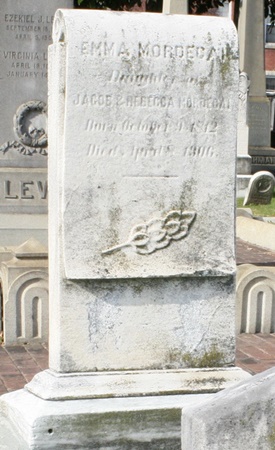
Pictured: Emm Mordecai's Grave, Hebrew Cemetery, Richmond.
She saw that it might be read at some future time and even went back to her her diary to comment on what seemed to her its incompleteness. She recorded that on 8 Novemer 1864, she "Got into an immoderate fit of laughter recalling an annecdote [sic] that John told us yesterday. It made me laugh after going to bed last night, all by myself -- Such a laugh is worth recording." Then at some later date she apparently penned an addendum to that entry saying, "Wish I had recorded the joke -- wonder I didn't. 1886."
We are all aware of the men who served and sacrificed and died during the Civil War, but often overlooked are the women who by social proscriptions of the time were required to stay at home, to maintain the home place and carry on. Their lives, experiences, observations and reactions were anything but dismissable, and the writings of Emma Mordecai, and others to be considered later, offer vivid proof.
Joey Boehling
>Back to Top<
A Note on the Diary
http://www2.lib.unc.edu/mss/m/Mordecai_Family.html#folder_96#1
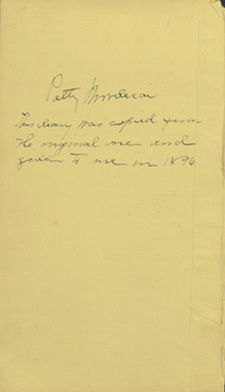
Emma Mordcai's diary was actually a transcription she made in 1886 and gave to Patty Mordecai in 1896. It is housed at the University of North Carolina and has been digitized and is available at the link above, the source of the image of the flyleaf on the left. This newsletter article made use of the bound typescript copy made in 1943 and housed at the Virginia Historical Society (Mss 5:1 M8115:1)
"The Mordecais of Rosewood" (The Henrico County Historical Society Magazine, 1989, 33-54) by students in Cathy Boehling's Program for the Gifted and Talented at Tuckahoe Middle School also provided invaluable background information.
>Back to Top<
Now You Know: For a Victorian Lady, Dressing Properly Could be a "Stretch" Requiring The Kid Glove Treatment
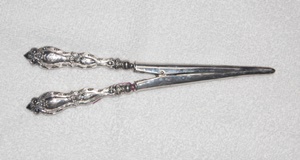
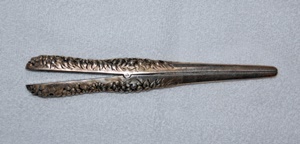
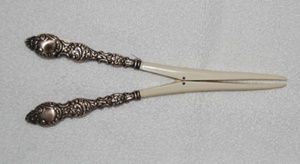
We congratulate Liess van der Linden-Brusse, a kindred spirit in one of our sister counties. He serves as chair of the Library Committee of the Chesterfield Historical Society of VA. He correctly identified the "What do you know?" item from our last issue as a glove stretcher. He also informed us that he has "a similar one, made of ivory, inherited from my grandparents in Holland! Not one of my seven grandkids had a clue as to what the item was!!"
The stretcher we depicted (bottom left photo) was made of silver and ivory. We've also included images of two others, both of which were made of sterling.
Victorians, it seems, had elaborately formed utensils for almost everything, and these items are no exception. Ladies wore very tight gloves, and to ease in putting them on, a glove stretcher was inserted into each finger, and the handles were squeezed, thereby separating the "blades" and stretching the finger. They were particularly helpful after gloves had been washed and had shrunk.
Yes, they actually washed the leather gloves, and in The Ladies' Book of Etiquette and Manual of Politeness (1860), Florence Hartley explains how those gloves could be washed. She writes: "make a strong lather with curd soap and warm water in which steep a small piece of new flannel. Place the glove on a flat, clean, and unyielding surface - such as the bottom of a dish, and having thoroughly soaped the flannel (when squeezed from the lather), rub the kid till all dirt be removed, cleaning and resoaping the flannel from time to time. Care must be taken to omit not part of the glove, by turning the fingers &c. The gloves must be dried in the sun, or before a moderate fire, and will present the appearance of old partchment. When quite dry, they must be gradually 'pulled out,' and will look new."
Putting on the gloves could be quite an undertaking, and a passage from The Lady's Dressing Room (1893) describes the process: "In putting on a pair of new gloves, the four fingers should be first inserted in the glove, leaving the thumb out, and the body of the glove should be turned back over the hand. When the fingers are quite in by means of the gentle movements of the other hand, introduce the thumb with the greatest care, leaning your elbow on your knee for support. Then turn back the glove on the wrist, and button the second button first, going on thus to the top. When this is done, come back to the first button, and you will find that it will button easily, without cracking the kid, which so often happens if one begins with the first button. Besides, it prevents the buttons-hole from widening; an important matter if you wish the glove to look well to the last."
And different gloves were required for different occasions. As Ms. Hartley notes, "In preparing a costume for a ball, choose something very light...White kid gloves, full trimmed, a fine lace trimmed handkerchief, and a fan, are indispensable." And she also says that for the opera, "Your gloves must be of kid, white, or some very light tint to suit your dress" and that "Your gloves you must keep on all the evening."
Items provided by Antique Boutique and Delectable Collection, 1310 East Cary Street.
>Back to Top<
Signals Sent Through the Language of the Glove
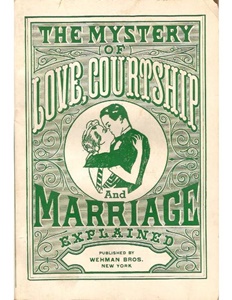
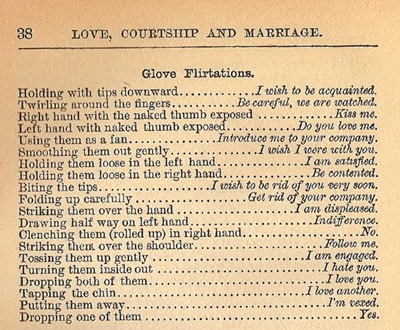
In 1890, Henry J. Wehman published The Mystery of Love, Courtship and Marriage Explained, in which he offered his advice and his observations on the etiquette relevant to the pursuit of love. The illustrations come from a reporting of the book from the first quarter of the twentieth century.
Included in the volume is the above list of supposed messages sent by ladies through their handling of their gloves.
If this is accurate, it was definitely a complex system of communication. While the widespread use of these flirtations as well as the universal ability to interpret of the intention of the actions is open to debate, one cannot deny that it is a fascinating possibility.
>Back to Top<
What Do You Know?
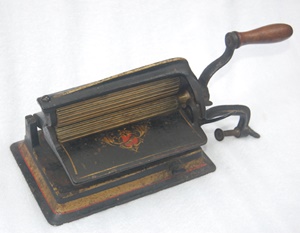
The base of the object pictured here is 9" long by 6" wide. The device is 5 1/2" tall. It is cast iron with red and gold stenciling. The two rollers are brass, and the handle on the crank is wooden. Just below the crank, a clamp is attached.
Do you know what it is?
Email your answers to jboehling@verizon.net.
>Back to Top<
News 2016: Second Quarter
First Quarter | Third Quarter | Fourth Quarter
Home | Henrico | Maps | Genealogy | Preservation | Membership | Shopping | HCHS
|











